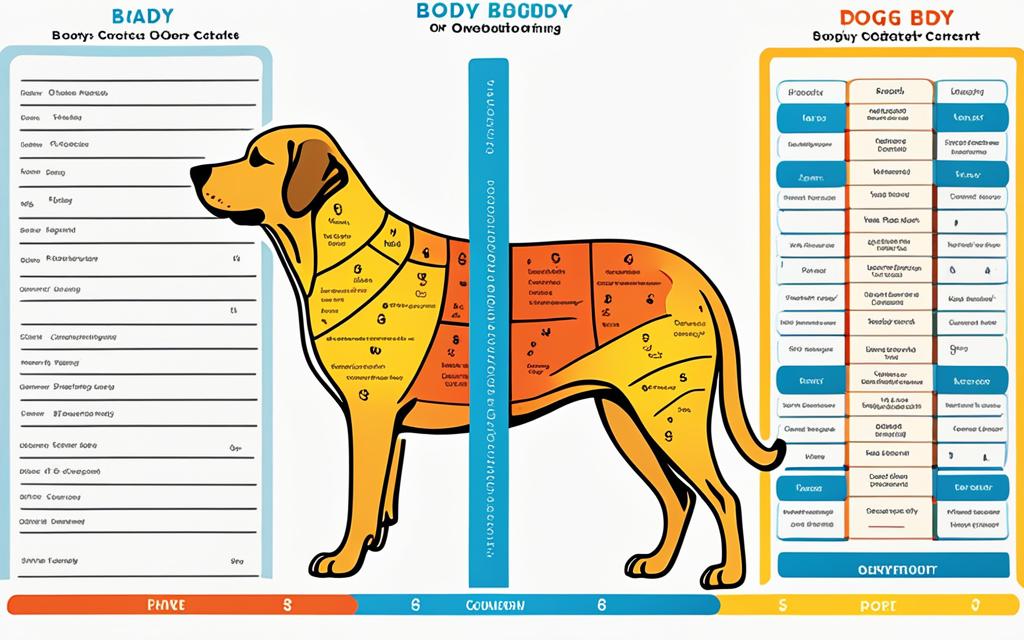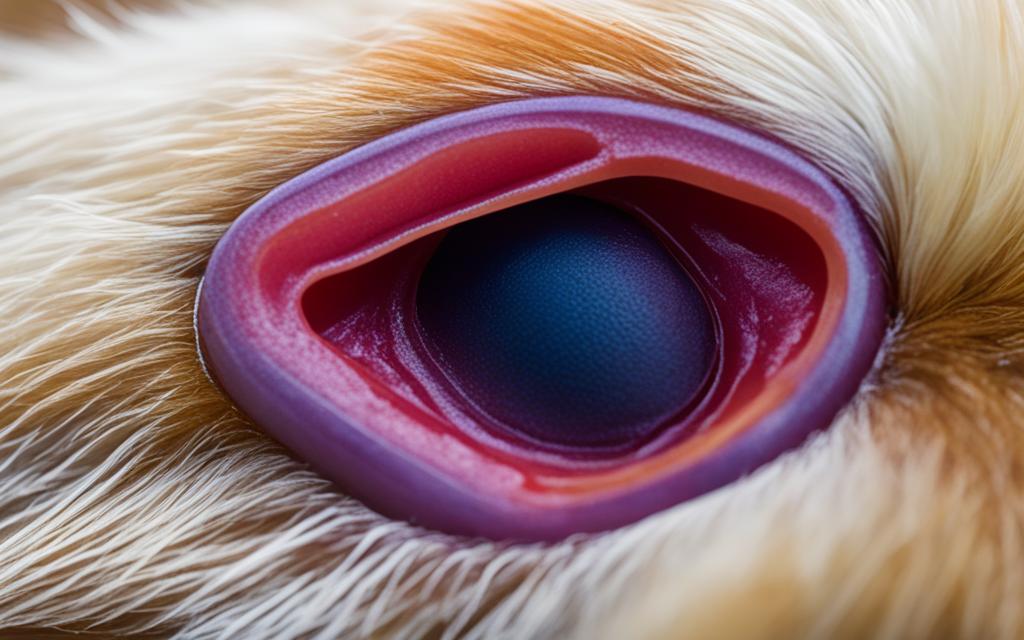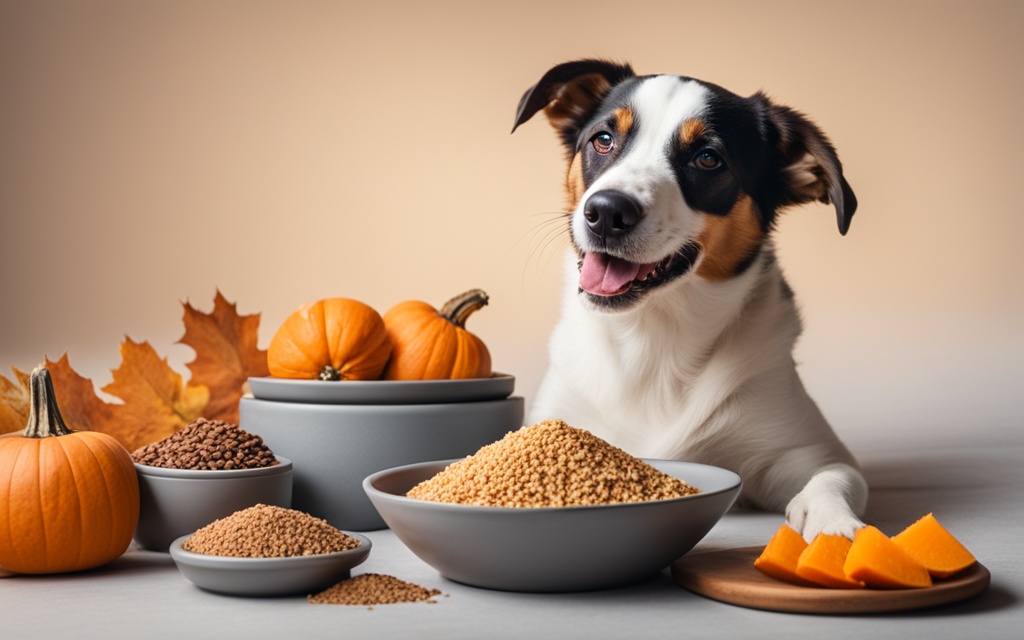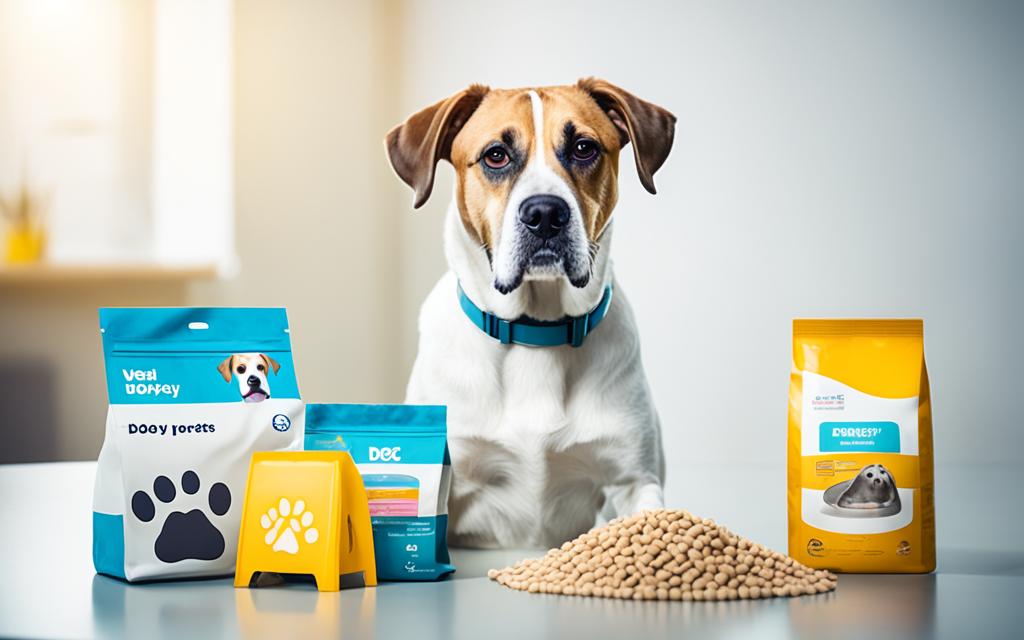Keeping your dog at a healthy weight is key for their health. Over 50% of pets are overweight or obese. It’s important to manage their weight to prevent health problems and boost their energy. This way, your dog can live a happier life.
By using the right strategies, your dog can stay fit and healthy. These strategies are key to fighting dog obesity. They help your dog live a long and active life.
Understanding Your Dog’s Ideal Weight
Finding out your dog’s ideal weight is key to their health. It depends on breed, age, sex, and size. Each breed has its own weight standards to keep them healthy.
Breed-specific weight charts are very useful. They show the right weight range for different breeds. This helps owners keep an eye on their dog’s fitness.
Getting advice from a vet is important for your dog’s weight. Regular vet visits can tell you if your dog is at a good weight. It’s important to make weight management plans that fit your dog’s needs for a healthy life.
| Breed | Weight Range (lbs) | Comments |
|---|---|---|
| Labrador Retriever | 55 – 80 | Commonly friendly, enjoys exercise to maintain weight. |
| Beagle | 20 – 30 | Active and social, requiring regular playtime. |
| German Shepherd | 50 – 90 | A fine balance of weight makes them agile and strong. |
| Poodle (Standard) | 40 – 70 | Intelligent breed, enjoys mental and physical challenges. |
| Chihuahua | 2 – 6 | Small but playful, requires portion control to avoid obesity. |
Understanding how breed, age, sex, and size affect a dog’s weight helps you keep your pet healthy for a long time.
The Importance of Regular Vet Check-ups
Regular vet visits are key for your dog’s health and weight. These check-ups help catch health issues early. Your vet can check your dog’s weight and condition, giving you advice for a better lifestyle.
Vets offer special advice on what your dog should eat. This depends on its age, breed, and how active it is. Getting advice from a pro helps make sure your dog eats right for its health and weight.
Going to the vet often lets you keep an eye on your dog’s weight and health. This way, you can act fast if your dog starts gaining weight for health reasons. Regular vet visits are a big step towards keeping your dog healthy and happy.
| Benefit of Vet Check-ups | Description |
|---|---|
| Early Detection | Identify weight-related health issues before they escalate. |
| Professional Assessment | Receive expert evaluations of your dog’s weight and condition. |
| Nutritional Guidance | Tailored diet plans to support your dog’s health and weight management. |
| Monitoring Progress | Track changes in weight, ensuring timely actions when needed. |
How to Maintain a Healthy Weight for Dogs
Keeping your dog at a healthy weight is key for their well-being and happiness. It means watching their diet and exercise closely. Tools like dog body condition scoring help you keep an eye on their fat levels. This way, you can make changes to help them stay at the right weight.
Assessing Your Dog’s Body Condition
A body condition score (BCS) chart is a great way to check your dog’s health. It tells you if your dog is too thin, just right, or overweight by looking at certain spots on their body.
- Feel the ribs. They should be easily felt without excess fat covering.
- Observe the waist from above. A visible waistline indicates a healthy weight.
- Check the abdomen. It should have a slight tuck when viewed from the side.
Calculating Ideal Weight Based on Breed
Every breed has its own perfect weight. Knowing the ideal weight for your dog’s breed is key to a good weight management plan.
| Breed | Ideal Weight (lbs) |
|---|---|
| Labrador Retriever | 55-80 |
| French Bulldog | 16-28 |
| Beagle | 20-30 |
| Golden Retriever | 55-75 |
| Boxer | 50-70 |
Checking your dog’s weight regularly and using body condition scoring helps you see when you need to make changes. Keeping an eye on these numbers makes it easier to manage your dog’s weight.

The Role of Diet in Weight Management
Managing your dog’s diet is key to keeping them at a healthy weight. Choosing the right dog food can greatly help with weight loss and overall health. Learning how to feed your dog right is crucial for their well-being.
Choosing the Right Dog Food
It’s important to pick quality dog food. Go for foods with lean proteins and whole ingredients. These support muscle health and reduce fat. Foods made for weight control are also a good choice.
Brands like Hill’s Science Diet and Royal Canin have special options for overweight dogs. These can help them lose weight effectively.
Portion Control and Feeding Guidelines
It’s vital to know how much to feed your dog. Adjust the amount based on their age, size, and how active they are. Use a measuring cup and feed them at the same time every day.
This stops them from eating too much and keeps their energy levels steady. Talking to your vet can help you find the best feeding plan for your dog. A regular feeding schedule is good for their health and behavior.
Establishing a Regular Exercise Routine
Creating a consistent exercise routine boosts a dog’s health and helps with weight management. It’s important to tailor these routines to fit different dog breeds. This keeps pets active and healthy. When planning an exercise plan, consider the activity levels and preferences of each breed.
Types of Exercise Suitable for Different Breeds
Dogs have different energy levels and exercise needs. Here are some exercise tips for various breeds:
| Dog Breed | Recommended Exercise | Duration |
|---|---|---|
| Small Breeds (e.g., Pug, Chihuahua) | Moderate walks, light play | 30 minutes daily |
| Medium Breeds (e.g., Beagle, Bulldog) | Brisk walks, fetch games | 45 minutes daily |
| Large Breeds (e.g., Labrador, German Shepherd) | Running, swimming, agility training | 60 minutes daily |
| Active Breeds (e.g., Border Collie, Australian Shepherd) | Running, hiking, complex work tasks | 90 minutes daily |
Interactive Play to Keep Your Dog Active
Interactive play strengthens the bond between dogs and their owners. It keeps dogs active and engaged. Games like fetch, tug-of-war, and hide-and-seek provide mental and physical exercise. Agility training is another fun way to combine structured exercise with play, fitting the energy levels of different breeds.
Adding these interactive elements to regular exercise routines keeps dogs happy and healthy.
Monitoring Weight Loss Progress
Keeping track of your dog’s weight loss is key for their health. Start a weight log to see patterns over time. This helps you adjust their diet and exercise plan as needed.
Weigh your dog regularly at home or during vet visits. Use the same scale each time for consistency. If you notice sudden changes in weight, it could mean health issues or diet/exercise needs.
Pay attention to your dog’s behavior too. Changes in appetite or energy could mean they’re losing or gaining weight. Understanding these signs helps you track their weight loss journey better.
It’s normal for dogs to have weight fluctuations. Don’t worry about small changes. Use your observations and data to adjust their weight management plan. Setting realistic goals, like losing a small percentage of weight each month, keeps you and your pet motivated.
![]()
| Tracking Method | Frequency | Notes |
|---|---|---|
| Weight Log | Weekly | Track weight changes and patterns. |
| Vet Visits | Every 4-6 weeks | Professional assessments of weight and health. |
| Behavioral Observations | Daily | Monitor appetite and activity levels for signs of change. |
Using these methods helps you keep an eye on your pet’s weight loss. Being active in your dog’s health journey ensures they live a happy, active life.
Healthy Treats and Alternatives
Choosing the right treats for your furry friend is key to their health. Healthy treats can prevent weight gain and boost your dog’s well-being. Many pet owners wonder about homemade versus store-bought treats. Knowing the pros and cons of each can guide you in picking the best for your dog’s diet.
Homemade Treats vs. Store-Bought
Homemade treats let you control what goes into them, ensuring your dog gets nutritious snacks. Ingredients like oats, peanut butter, and pumpkin are common in these recipes. But, store-bought treats offer convenience and variety, though they might have fillers and preservatives. Always check the label for quality when picking store-bought treats.
| Type | Benefits | Drawbacks |
|---|---|---|
| Homemade Treats | Control over ingredients, customizable recipes | Time-consuming to make, may spoil faster |
| Store-Bought Treats | Convenient, variety of options available | Potentially unhealthy additives, may be more expensive |
Treats That Promote Weight Loss
For dogs needing to lose weight, low-calorie snacks can help. Look for treats with low-fat ingredients that are nutritious but not too calorie-dense. Carrot sticks, apple slices, or low-calorie dog treats are great choices. Adding these to your dog’s diet can satisfy their cravings without harming their health.
Common Weight Management Mistakes to Avoid
Managing your dog’s weight is key for their health. Many dog owners make mistakes that hurt their efforts. Knowing these pitfalls is key to keeping your pet at a healthy weight.
One big mistake is not measuring food correctly. It’s easy to think you’re giving the right amount but actually overfeed your dog. Using a scale or measuring cups helps avoid this and keeps your pet healthy.
Not exercising your dog enough is another common error. Dogs need to move to stay fit and burn calories. Without enough exercise, they can gain weight, even if they’re not eating too much. Daily walks and playtime can help prevent this.
Too many treats are a big mistake for pets. Treats are good for training, but too many add extra calories. Choose low-calorie treats or cut them into smaller pieces to keep your dog healthy without overfeeding.
Not talking to a vet can also hurt your dog’s weight management. A vet can give advice that fits your dog’s health needs. Regular vet visits help track progress and adjust your dog’s diet and exercise.
Adjusting Weight Management Plans as Needed
Every dog is unique, and their weight management plans should reflect that. It’s key to adjust your dog’s diet as they age or change in activity. Regular checks can show if the current plan is working.
If your dog becomes less active or gets health issues, you’ll need to change how you help them lose weight. This might mean eating less or doing different exercises.
Talking often with vets is a big part of managing your pet’s weight. They can look at how your dog is doing and suggest changes. Since dogs age, their metabolism changes, so it’s important to keep an eye on their diet and exercise.
It’s important to adapt to your dog’s lifestyle. Set up regular check-ins to see how they’re doing and make changes as needed. This could mean changing how much they eat or finding new exercises they like. Keeping in touch with your vet can help you get the best results.
Conclusion
Keeping your dog at a healthy weight is key for their happiness and health. We’ve looked at ways to help your dog stay fit, from knowing their ideal weight to keeping them active. A healthy weight means they can move better, live longer, and be happier.
Feeding them the right food in the right amounts is important. Regular vet visits and adjusting training help keep an eye on their weight loss. By focusing on keeping your dog fit, you make their life full of energy and joy.
In short, keeping your dog at a healthy weight is vital for their health. Start using these tips now, and you’ll see big improvements in your pet’s life. It will make every day with them more special.




